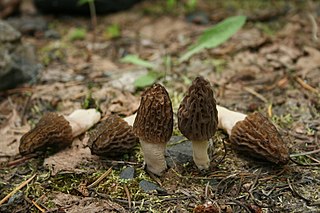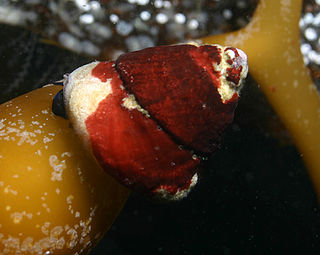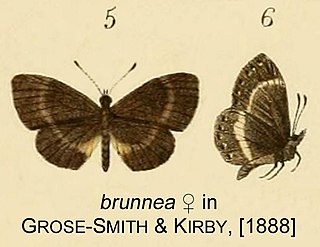
The brown hyena, also called strandwolf, is a species of hyena found in Namibia, Botswana, western and southern Zimbabwe, southern Mozambique and South Africa. It is the only extant species in the genus Parahyaena. It is currently the rarest species of hyena. The largest remaining brown hyena population is located in the southern Kalahari Desert and coastal areas in Southwest Africa. The global population of brown hyena is estimated by IUCN at a number between 4,000 and 10,000 and its conservation status is marked as near threatened in the IUCN Red List.

The Indian blue robin is a small bird found in the Indian Subcontinent. Formerly considered a thrush, it is now considered one of the Old World flycatchers in the family Muscicapidae. It was earlier also called the Indian blue chat. It is migratory, breeding in the forests along the Himalayas of Nepal, India, Myanmar and Bangladesh. They winter in the hill forests of the Western Ghats of India and in Sri Lanka.

Scotorythra is a genus of moths in the family Geometridae erected by Arthur Gardiner Butler in 1883. All species of this genus are endemic to Hawaii.
Diarhabdosia is a genus of moths in the subfamily Arctiinae. The genus was erected by George Hampson in 1900.

Bispira brunnea, the social feather duster or cluster duster, is a species of marine bristleworm. They tend to live in groups of individuals, and are common off the Caribbean islands in southeast North America. The feather duster has one crown of various colors, however, the color of the crown seems to be consistent within individual colonies.

Noctua fimbriata, the broad-bordered yellow underwing, is a moth of the family Noctuidae. It is found in Europe, North Africa, Anatolia, the Caucasus, Turkey, Caucasus, Transcaucasia, Armenia, Turkmenistan and Novosibirsk Oblast. The border of its southern range is unclear because of the similar looking species Noctua tirrenica.

Diarsia brunnea, the purple clay, is a moth of the family Noctuidae. The species was first described by Michael Denis and Ignaz Schiffermüller in 1775. It is found in most of Europe, east to Transcaucasia, the Caucasus, central Asia, Siberia, the Kuriles, Amur, Ussuri, Sakhalin, Korea, Japan, and China, including China's Tibet region.

The thick-tailed shrew is a species of mammal in the family Soricidae. It is found on the islands of Java and Bali in Indonesia.

Morchella brunnea is a species of fungus in the family Morchellaceae. Described as new to science in 2012, it is known from Oregon, where it fruits under hardwood trees.

Tegula brunnea, common name the brown turban snail, is a species of medium-sized sea snail, a marine gastropod mollusk in the family Tegulidae,.

Micropentila brunnea, the brown dots, is a butterfly in the family Lycaenidae. It is found in Sierra Leone, Liberia, Ivory Coast, Ghana, Nigeria, Cameroon, Equatorial Guinea, Gabon, the Republic of the Congo and the Democratic Republic of the Congo. The habitat consists of primary forests.
Alucita brunnea is a moth of the family Alucitidae. It is found in the Amazon basin.
Eois brunnea is a moth in the family Geometridae. It is found in south-eastern Peru.
Diarhabdosia minima is a moth of the subfamily Arctiinae first described by Arthur Gardiner Butler in 1878. It is found from Mexico to the Amazon region.
Diarhabdosia strigipennis is a moth of the subfamily Arctiinae. It is found in French Guiana.
Givira brunnea is a moth in the family Cossidae. It is found in Argentina.
Habrona is a genus of moths belonging to the subfamily Thyatirinae of the Drepanidae.
Habrona brunnea is a moth in the family Drepanidae. It is found in New Guinea and on the Moluccas. The habitat consists of mountainous areas.
Brachmia brunnea is a moth in the family Gelechiidae. It was described by John David Bradley in 1961. It is found on Guadalcanal.

Acanthodoris brunnea, common name the brown horned dorid, is a species of sea slugs, a dorid nudibranch, a shell-less marine gastropod mollusc in the family Onchidorididae.










